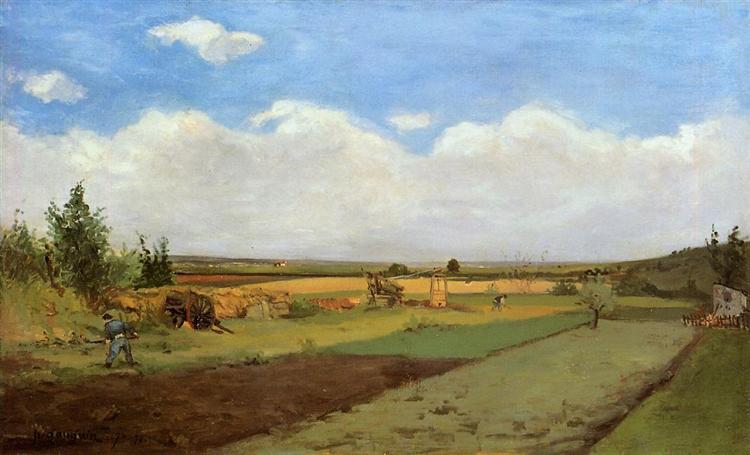Description
Paul Gauguin's painting "Working the Land" (1873) is a profound testament to rural life in the 19th century, reflecting not only the dedication to agriculture, but also the interaction of humans with their environment. Using his distinctive post-impressionist approach, Gauguin offers a depiction that goes beyond the mere pastoral scene; it is a meditation on labor, community, and the essence of physical work.
The composition of the work is notable for its simplicity and effectiveness. In the foreground, Gauguin presents a group of workers, who are in the midst of their agricultural duties. The figures, although stylized and almost iconic, convey a visceral connection with the land they till. The posture of the workers, hunched over their task, evokes a perspective of total dedication to the agricultural effort. These characters seem to be both actors and elements of a landscape, where each figure, with solid lines and defined contours, blends into the natural environment.
Color in Working the Land is central to creating this atmosphere of labor and connection. Gauguin uses an earthy color palette that highlights the intimate relationship between man and the land. Brown and green tones predominate, suggesting fertility and hard work, while hints of yellow and orange add a brightness that evokes both sunlight and the hope of growth. This use of color also reflects the influence of the split-color technique, where the contrast between tones creates a dynamism that engages the viewer.
The work not only presents agricultural work as a simple everyday act; it also captures the spirit of community and tradition. Although it does not feature mythological or exotic elements as in Gauguin's later works, Working the Land falls into a series of works that portray rural life with a strong symbolic charge. Gauguin's quest to show the dignity of human labor through balanced compositions and a clear focus can be seen in his contemporary and later works, where the human figure and the natural environment are equally important.
Another aspect that is worth mentioning is the historical context of the creation of this work. At a time when Impressionism was in full swing, Gauguin began to develop his own style, fusing the technique of Impressionism with more personal and subjective influences. The depiction of acts of work and everyday life is a precursor to his future exploration of the culture and mythology of more exotic places, such as Polynesia, which became his strong motivation in later decades.
Working the Land is an early example of Gauguin's interest in themes of working life and agricultural traditions, which would serve as a basis for exploring more complex concepts about humanity, culture and the environment. Through this work, the viewer is invited not only to contemplate a scene of work, but also to reflect on the meaning of labor in human life. Through his unique style, Gauguin manages to capture a moment that resonates with the eternity of man's experience working in harmony with nature.
KUADROS ©, a famous painting on your wall.
Hand-made oil painting reproductions, with the quality of professional artists and the distinctive seal of KUADROS ©.
Painting reproduction service with satisfaction guarantee. If you are not completely satisfied with the replica of your painting, we will refund 100% of your money.

